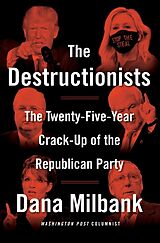The Destructionists
Einband:
Fester Einband
EAN:
9780385548137
Untertitel:
The Twenty-Five Year Crack-Up of the Republican Party
Genre:
Politikwissenschaft
Autor:
Dana Milbank
Herausgeber:
Random House N.Y.
Anzahl Seiten:
416
Erscheinungsdatum:
09.08.2022
ISBN:
978-0-385-54813-7
Autorentext
Dana Milbank
Klappentext
"A scathing history of twenty-five years of Republican attempts to hold on to political power by any means necessary, by a hugely popular Washington Post political columnist"--
Zusammenfassung
NEW YORK TIMES BEST SELLER • A scalding history of twenty-five years of Republican attempts to hold on to political power by any means necessary, by a hugely popular Washington Post political columnist
"A thorough and scathing account of how the Republican Party fell prey to Trumpism."—The New York Times Book Review
In 1994, more than 300 Republicans under the command of obstructionist and rabble-rouser Congressman Newt Gingrich stood outside the U.S. Capitol to sign the Contract with America and put bipartisanship on notice. Twenty-five years later, on January 6, 2021, a bloodthirsty mob incited by President Trump invaded the Capitol.
Dana Milbank sees a clear line from the Contract with America to the coup attempt. In the quarter century in between, Americans have witnessed the crackup of the party of Lincoln and Reagan, to its current iteration as a haven for white supremacists, political violence, conspiracy theories and authoritarianism.
Following the questionable careers of party heavyweights Newt Gingrich, Karl Rove, Mitch McConnell, and Rudy Giuliani, and those of many lesser known lowlights, Milbank recounts the shocking lengths the Republican Party has gone to to maintain its grip on the American people.
Leseprobe
Chapter 1
Shooting at Melons
At the start of the Civil War, Union troops built Fort Marcy, on a ridge above the Potomac in Northern Virginia, as one of the fortifications ringing Washington to protect the capital from Confederate attack. The Union commander, General George McClellan, named it for his father-in-law and chief of staff, Randolph Marcy. Its earthworks measured up to eighteen feet thick in parts, and it bristled with three howitzers and eighteen field guns, defending the Chain Bridge river crossing below.
In the end, Fort Marcy wound up seeing no major action in the Civil War. But more than a century later, it became the site of the first shot in another conflict: the Republican Party’s war on truth.
The afternoon of July 20, 1993, brought the kind of oppressive weather that keeps almost everybody indoors: a high of 96 degrees and near 100 percent humidity. But sometime after the lunch hour, a gray Honda Accord with Arkansas plates, heading westbound on the George Washington Memorial Parkway, pulled off at Fort Marcy, now a national park. A man in his late forties, lanky and nearly six feet five inches tall, emerged from the Honda wearing a white dress shirt, gray dress pants, and black dress shoes. He left his sports jacket and his swan-pattern tie folded on the passenger seat, and he pocketed the car keys.
The man proceeded to walk uphill some eight hundred feet from the parking lot to the walls of the old fort, then continued to the second of two vintage 12-pound howitzers on display. Stopping on the steeply sloping earthworks just below the old cannon, the man pulled from his pants pocket an antique Colt .38 revolver. He put the barrel of the gun in his mouth and, with his right thumb, squeezed the trigger.
Hours later, after the man’s body had been discovered by a passerby, U.S. Park Police searching the Honda found, under the suit jacket, the man’s White House identification. The deceased was Vince Foster, the deputy White House counsel and personal friend of President Bill Clinton and First Lady Hillary Clinton.
Foster’s death was a tragic suicide. Since moving to Washington with the new administration, Foster had been battered in the press, particularly in the editorial pages of The Wall Street Journal, for his role in various penny-ante scandals of the first year of the Clinton presidency that ultimately amounted to nothing. Four days before his death, Foster broke down in tears at dinner with his wife and talked of resigning. He also told his sister he was depressed, and she gave him the names of three psychiatrists (the list was found in his wallet), and he tried to reach one of them but got an answering machine. The day before his death, he called his doctor in Little Rock and complained of stress, anorexia, and insomnia, and he received a prescription for an antidepressant.
Investigators deduced that the gun was an eighty-year-old model he had inherited from his father. He transported it in an oven mitt, found in his car’s glove compartment. Forensic evidence—gunshot residue on his hands, a mark on his thumb matching the trigger rebound, no indication of struggle—overwhelmingly pointed to suicide. And there was a note—torn into twenty-seven pieces, it was found in his briefcase, which he had left at the office.
“I made mistakes from ignorance, inexperience and overwork,” it said. “I did not knowingly violate any law or standard of conduct.” He listed various grievances—“The GOP has lied. . . . The public will never believe the innocence of the Clintons and their loyal staff. The WSJ editors lie without consequence”—and ended with this: “I was not meant for the job or the spotlight of public life in Washington. Here ruining people is considered sport.”
Alas for Foster, even death offered no relief from that sport. Republicans were about to ruin him—posthumously.
Almost exactly a year after Foster’s suicide, Dan Burton, a Republican congressman from Indiana and a close ally of Republican whip Newt Gingrich, stood in the well of the House of Representatives, giving an hour-long special order speech.
His purpose: to make the case that Vince Foster had been murdered. His proof: Burton shot a melon in his backyard.
The precise identity of the gourd Burton shot is a matter of some dispute. It has been identified, variously, as a watermelon, a pumpkin, and a cantaloupe. But this much is clear: Burton had used the gourd as a stand-in for Foster’s head—“a head-like thing,” he called it—to prove that it’s impossible Foster shot himself at Fort Marcy and nobody heard the gunshot.
“We, at my house, with a homicide detective, tried to re-create a head and fired a .38 inch barrel into that, to see if the sound could be heard from 100 yards away,” Burton declared on the House floor. “Even though there was an earth mover moving around in the background, making all kinds of racket, you could hear the bullet clearly.”
Investigators of Foster’s death found the lack of witnesses reporting a gunshot unsurprising: the strip of woods, with infrequent foot traffic, lies between the parkway and another busy road. But Burton took the unheard gunshot as evidence that Foster had been murdered at a different location, rolled up in a carpet, and carried in broad daylight uphill to the fort, with care being taken to hold the six-foot-four-and-a-half-inch corpse upright to keep the blood off his clothing.
“He died under very mysterious circumstances,” Burton told the House. “His body was moved. There is no question about it.” Burton suggested that the gun was planted in Foster’s hand and that the torn note was planted in his briefcase. Burton floated the possibility of a secret entrance to the park, and killers hiding in the trees. He asserted that “there is a connection” between Foster’s death and probes of the Clintons’ finances. …

Leider konnten wir für diesen Artikel keine Preise ermitteln ...
billigbuch.ch sucht jetzt für Sie die besten Angebote ...
Die aktuellen Verkaufspreise von 6 Onlineshops werden in Realtime abgefragt.
Sie können das gewünschte Produkt anschliessend direkt beim Anbieter Ihrer Wahl bestellen.
Loading...
Die aktuellen Verkaufspreise von 6 Onlineshops werden in Realtime abgefragt.
Sie können das gewünschte Produkt anschliessend direkt beim Anbieter Ihrer Wahl bestellen.
| # | Onlineshop | Preis CHF | Versand CHF | Total CHF | ||
|---|---|---|---|---|---|---|
| 1 | Seller | 0.00 | 0.00 | 0.00 |
